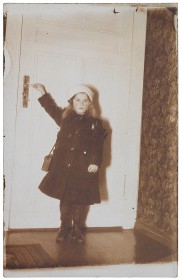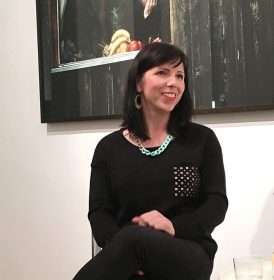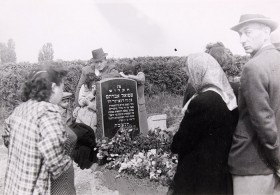A Photo Collection Found Hiding in Berlin-Friedrichshain

A girl standing in front of a door, presumably Berlin, about 1918–1922; Jewish Museum Berlin
Every time I open a new folder of photos, I can’t know what’s waiting for me – what faces I’ll find or fates will be revealed. Images are often part of a larger collection, consisting of documents, everyday articles and artwork, for which we already know the biographies of those pictured or can further research. Such was the case, for example, of the cabaret artist, Olga Irén Fröhlich, whom I’ve written about before on this blog. This time, however, the people in the photographs will remain unknown to me; I won’t be able to attach names or histories to them. Perhaps you can!
It’s not out of the ordinary to work with collections that have been in the Museum’s possession for decades. → continue reading
Photo Portraits by Noga Shtainer

Noga Shtainer during an artist talk celebrating her show in Berlin in 2015 © Noga Shtainer
Noga Shtainer often travels with her camera in tow, for her photography project “Home for Special Children” in the Ukraine, for instance, or for “Twins” in Brazil. Shots from the latter project have been available for purchase from the art vending machine since 1 April 2016 (further information on our website). The photographer has lived since 2010 in Berlin, where I met her two years ago (I wrote about that encounter in a blog post in May of 2015).
The fact that Noga Shtainer is a photographer is itself accidental. She set out to become an actress. But she didn’t pass the entrance auditions for the WIZO School of Art in Haifa and was encouraged instead to apply for a photography class. The deadline for submitting an application portfolio was only two days away, however. → continue reading
The Tragic Fate of Shmuel Dancyger Z. L.

The family at the grave of Shmuel Dancyger; Jewish Museum Berlin, gift of Morris Dancyger
During a visit to my hometown of Calgary Alberta, Canada in the summer of 2014, I had the opportunity to meet with Morris and Ann Dancyger, both child survivors of the Holocaust. Morris Dancyger was one of the very few children to have been liberated by the Russians at Auschwitz on 27 January 1945. In the iconic footage of the children displaying their tattooed arms, four year old Morris is in the center of the picture. Ann Dancyger and her mother had miraculously survived an execution in 1942 near the town of Ratno where she was born, and spent nearly three years thereafter in hiding. After a nearly two year trek to Germany following the end of the war, she was able to come to Calgary where relatives lived. I had not known the Dancygers while growing up in the city, and although I had much later read about the tragic fate of Morris Dancyger’s father Shmuel, I was completely unaware that his wife and children had settled in Calgary. → continue reading


